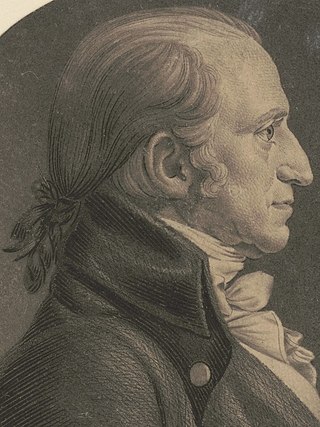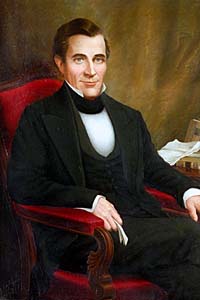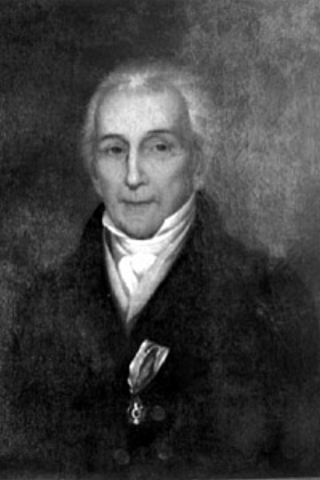
The Northwest Ordinance, enacted July 13, 1787, was an organic act of the Congress of the Confederation of the United States. It created the Northwest Territory, the new nation's first organized incorporated territory, from lands beyond the Appalachian Mountains, between British North America and the Great Lakes to the north and the Ohio River to the south. The upper Mississippi River formed the territory's western boundary. Pennsylvania was the eastern boundary.
Fletcher v. Peck, 10 U.S. 87 (1810), was a landmark United States Supreme Court decision in which the Supreme Court first ruled a state law unconstitutional. The decision created a growing precedent for the sanctity of legal contracts and hinted that Native Americans did not hold complete title to their own lands.

The Northwest Territory, also known as the Old Northwest and formally known as the Territory Northwest of the River Ohio, was formed from unorganized western territory of the United States after the American Revolution. Established in 1787 by the Congress of the Confederation through the Northwest Ordinance, it was the nation's first post-colonial organized incorporated territory.

The Yazoo lands were the central and western regions of the U.S. state of Georgia, when its western border stretched back to the Mississippi. The Yazoo lands were named for the Yazoo nation, that lived on the lower course of the Yazoo, in what is now Mississippi.
James Gunn was a delegate to the Continental Congress and a United States Senator from Georgia.

The Territory South of the River Ohio, more commonly known as the Southwest Territory, was an organized incorporated territory of the United States that existed from May 26, 1790, until June 1, 1796, when it was admitted to the United States as the State of Tennessee. The Southwest Territory was created by the Southwest Ordinance from lands of the Washington District that had been ceded to the U.S. federal government by North Carolina. The territory's lone governor was William Blount.

The Territory of Oklahoma was an organized incorporated territory of the United States that existed from May 2, 1890, until November 16, 1907, when it was joined with the Indian Territory under a new constitution and admitted to the Union as the state of Oklahoma.

The Territory of Mississippi was an organized incorporated territory of the United States that was created under an organic act signed into law by President John Adams on April 7, 1798, and was dissolved on December 10, 1817, when the western half of the territory was admitted to the Union as the State of Mississippi. The eastern half was redesignated as the Alabama Territory until it was admitted to the Union as the State of Alabama on December 14, 1819. The Chattahoochee River played a significant role in the definition of the territory's borders. The population rose in the early 1800s from settlement, with cotton being an important cash crop.

George Poindexter was an American politician, lawyer, and judge from Mississippi. Born in Virginia, he moved to the Mississippi Territory in 1802. He served as United States Representative from the newly admitted state, was elected as Governor (1820–1822), and served as a United States senator.

John Milledge was an American politician. He fought in the American Revolution and later served as United States Representative, 26th Governor of Georgia, and United States Senator. Milledge was a founder of Athens, Georgia, and the University of Georgia. From January to May 1809, Milledge served briefly as President pro tempore of the United States Senate.

James Jackson was an early British-born Georgia politician of the Democratic-Republican Party. He was a member of the U.S. House of Representatives from 1789 until 1791. He was also a U.S. Senator from Georgia from 1793 to 1795, and from 1801 until his death in 1806. In 1797 he was elected 23rd Governor of Georgia, serving from 1798 to 1801 before returning to the senate.

Jared Irwin served twice as elected Governor of Georgia (1796–1798) and (1806–1809). He first was elected to office as a reformer based on public outrage about the Yazoo land scandal. He signed a bill that nullified the Yazoo Act, which had authorized the land sales. Challenges to land claims purchased under the former act led to the United States Supreme Court's hearing the case Fletcher v. Peck (1810). In a landmark decision, the Court upheld the land contracts, and ruled that the state law was unconstitutional in trying to nullify valid contracts.

The Chickasaw Nation is a federally recognized Native American tribe with headquarters in Ada, Oklahoma, in the United States. They are an Indigenous people of the Southeastern Woodlands, originally from northern Mississippi, northwestern Alabama, southwestern Kentucky, and western Tennessee. Today, the Chickasaw Nation is the 13th largest tribe in the United States.
From 1789 to 1796, Georgia governors George Walton, Edward Telfair, and George Mathews, while in office, made gifts of land grants covering more than three times as much land as Georgia then contained. In all they made grants of 29,097,866 acres (117,755 km²) of land in counties that consisted of only 8,717,960 acres (35,280 km²).

John Wereat was an American politician and the Governor of Georgia.

The Georgia land lotteries were an early nineteenth century system of land redistribution in Georgia. Under this system, white male citizens could register for a chance to win lots of land that had been taken from the Muscogee and the Cherokee Nation. The lottery system was utilized by the State of Georgia between the years 1805 and 1833 “to strengthen the state and increase the population in order to increase Georgia's power in the House of Representatives.” Although some other states used land lotteries, none were implemented at the scale of the Georgia contests.
The Trans-Oconee Republic was a short-lived, independent state west of the Oconee River. Established by General Elijah Clarke in May 1794, it was an attempt to head off the new Federal government's ceding of lands claimed by Georgia back to the Creek. In September 1794, state and federal troops forced Clarke and his followers to surrender and leave the settlements. The armed forces destroyed the houses and forts.
City of Sherrill v. Oneida Indian Nation of New York, 544 U.S. 197 (2005), was a Supreme Court of the United States case in which the Court held that repurchase of traditional tribal lands 200 years later did not restore tribal sovereignty to that land. Justice Ruth Bader Ginsburg wrote the majority opinion.

The Marshall Court (1801–1835) issued some of the earliest and most influential opinions by the Supreme Court of the United States on the status of aboriginal title in the United States, several of them written by Chief Justice John Marshall himself. However, without exception, the remarks of the Court on aboriginal title during this period are dicta. Only one indigenous litigant ever appeared before the Marshall Court, and there, Marshall dismissed the case for lack of original jurisdiction.
Bourbon County, Georgia was a county of the U.S. state of Georgia from 1785 to 1788. The county was created by Georgia in 1785 as part of the Yazoo land scandal out of disputed Yazoo lands in present-day Mississippi and was dissolved in 1788 due to pressure from the federal government.















